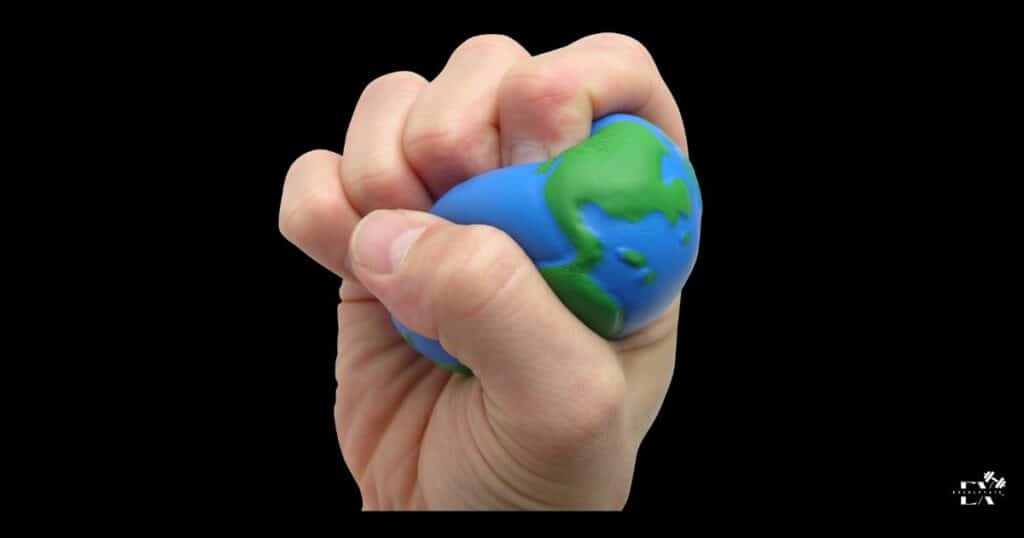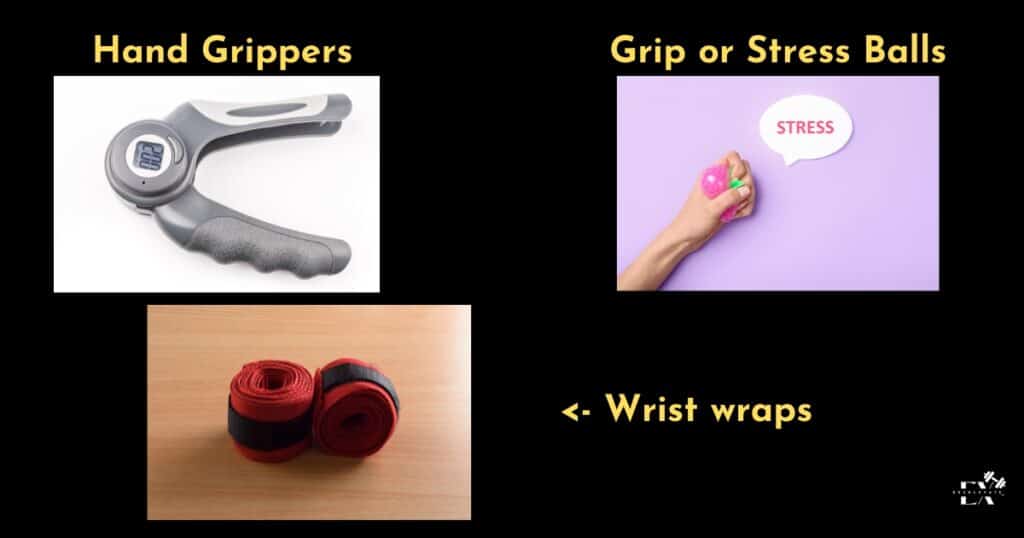
Is Grip strength holding you back from lifting heavy deadlifts?
Strong grips are crucial for the deadlift, one of the key exercises for building strength and power. However, it is often ignored as a training component.
A strong grip not only makes it possible to hold onto heavy weights but also improves performance as a whole and reduces the risk of injury.
It’s time to work on your grip strength when deadlifting if you find it difficult to keep a tight grasp on the bar.
Improving grip strength offers numerous benefits beyond deadlifts. It carries over to various other exercises like pull-ups, rows, and even everyday tasks that require gripping and lifting.
Additionally, a strong grip can improve wrist stability, forearm strength, and overall upper body power.
To enhance your grip strength for deadlifts and beyond, this article will provide a comprehensive guide. We’ll delve into understanding grip strength, assess your current abilities, and explore effective exercises tailored specifically for improving grip strength.
We’ll discuss the role of grip strengtheners, tools, and accessories, as well as supplementary techniques to enhance grip endurance.
In addition, we’ll also discuss how diet and recovery help in the development of grip strength. So let’s get started.
Understanding Grip Strength
A key component of total strength and functional abilities is grip strength. It is referred as physical power exerted by the hand and forearm muscles to secure a firm hold on an object.
It is important in a variety of activities, including athletics and weightlifting as well as daily activities like carrying groceries or opening jars.
Crush Grip: This type of grip strength involves squeezing or closing the hand forcefully, typically using all four fingers and the thumb. It is for activities like holding a barbell or dumbbell during exercises such as deadlifts, rows, or bench presses.

Pinch Grip: The pinch grip is distinguished by the capacity to maintain a firm grip on an object between the thumb and fingers. It is essential for actions like holding onto the edge of a heavy plate or holding little things. , Pinch grip strength is frequently tested by squeezing two plates together or by using pinch grippers.
Support Grip: Support grip strength involves the capacity to keep a tight hold for an extended duration. For example, hanging from a pull-up bar or lifting heavy weights both need the ability to hold for a longer period of time.
Hook Grip: The hook grip is commonly used in weightlifting, particularly during the deadlift and snatch. It involves placing the thumb inside the closed fingers, allowing for a safe grip on the barbell.

Double Overhand Grip: The double overhand grip refers to holding a barbell or other objects with both palms facing towards the body. This grip style focus on grip strength development and is often used in training to enhance grip endurance.
Mixed Grip: Holding the barbell with one hand up and the other palm down is known as the mixed grip. This grip is commonly used in heavy deadlifting to enhance grip strength and prevent the bar from slipping out of hands.
Understanding the different types of grip strength allows individuals to identify specific areas for improvement and tailor their training accordingly. By targeting each component through specific exercises and techniques, individuals can develop a well-rounded grip strength that enhances performance in various activities and promotes overall strength and functionality.
Assessing Your Current Grip Strength
To improve your grip strength effectively, it is crucial to assess your current abilities and identify areas for improvement. By understanding your strengths and weaknesses, you can develop a targeted training plan that addresses specific grip challenges.
Various Methods to Measure Grip Strength
Hand Dynamometer: It is a device specifically designed to measure grip strength. Allowing you to squeeze the device with maximum force, providing a numerical reading of your grip strength.

Pinch Strength Test: This test assesses pinch grip strength by measuring the force exerted between the thumb and fingers. It can be done using a pinch gauge or by using objects like plates or grippers.
Identifying Weaknesses and Areas for Improvement of grip strength
After evaluating your grip strength, it’s important to identify your weaknesses and areas that need to be strengthened.
Grip Fatigue: Note how long you can maintain a strong grip before experiencing fatigue or the grip starts to weaken.
Grip Endurance: Evaluate your ability to sustain a firm grip over an extended period, such as during long holds or static exercises.
Specific Weaknesses: Assess if you struggle more with crush grip, pinch grip, support grip, or any other specific grip type.
Grip Differences: Check to see whether one hand is significantly weaker than the other; if so, there may be a problem that has to be fixed.
By evaluating your grip strength using these various methods, and identifying weaknesses and areas for improvement, you can develop a targeted training plan. This plan will help you focus on specific grip types and address imbalances, leading to a well-rounded and stronger grip overall. Regular reassessment of grip strength will also allow you to track progress and adjust your training as needed.
Effective Exercises for Grip Strength Improvement
Developing grip strength is important for everyday living as well as for workouts like deadlifts. When done correctly, a number of exercises may drastically improve your grip strength.
Farmer Walks
Firstly, Farmer’s Walks are an effective and simple way to build grip strength. They involve carrying heavy weights by your sides for a distance. Begin with manageable weights, focusing on keeping your shoulders back and core engaged. As your strength improves, gradually increase the weight and distance. Farmer’s Walks benefit grip strength by forcing your hands to clamp down on the weights for an extended period.
Plate Pinches
Plate Pinches, another excellent exercise, require pinching weight plates between your fingers and thumb, then holding for as long as possible. Start with lighter weights, ensuring a secure grip. Progress by adding more weight or holding for longer durations. This exercise directly targets your pinch grip, a crucial aspect of overall grip strength.
Dead Hangs
Dead Hangs are highly effective for enhancing grip strength. Hang from a pull-up bar with both hands for as long as you can. Experiment with different grip positions, such as overhand or underhand, to work different muscles. Start with shorter durations and increase as your strength improves.
Fat Grip Training
Lastly, consider Fat Grip Training, which involves using thicker bars for your exercises. Fat grips make the bar harder to hold, forcing your muscles to work harder and thus improving grip strength. Incorporate them into your routine with exercises like bicep curls or deadlifts. Always remember, consistency is key in training for grip strength improvement.
Grip Strengthening Tools and Accessories
Grip strengtheners (hand grippers)
One of the most common tools is grip strengtheners, often referred to as hand grippers. These devices have different resistance levels, ranging from light to heavy, to cater to various fitness levels. To use them effectively, simply squeeze the handles together repeatedly, ensuring a full grip and release to maximize muscle engagement.
Grip balls and stress balls
Grip balls and stress balls are another beneficial tools for improving grip strength. By providing resistance when squeezed, these balls can help enhance hand and finger strength. Exercises can include individual finger squeezes, full hand squeezes, and even pinch grips. Regular use can significantly improve hand dexterity and grip power.

Wrist wraps and straps
Wrist wraps and straps, while not directly used to strengthen the grip, can provide support when performing heavy lifts such as deadlifts. They wrap around your wrist and the weight, taking some of the load off your grip and allowing you to lift heavier. However, their use should be moderated to avoid over-reliance and potential wrist weakness.
Remember, while these tools can aid grip strength development, it’s vital to maintain a balanced training regimen and listen to your body’s cues to prevent overuse injuries.
Supplementary Techniques for Grip Strength Enhancement
Forearm exercises
For optimal grip strength, it’s essential to consider not just direct grip exercises, but also supplementary techniques that focus on the muscles involved in grip, particularly the forearms.
Wrist curls and Reverse curls
Wrist curls are a fundamental forearm exercise, performed using a barbell or dumbbells. By flexing and extending your wrist while keeping your arm stationary, you engage the muscles responsible for wrist movement, which are integral for grip. Reverse curls, performed by curling weights with an overhand grip, target the brachioradialis, a muscle that supports grip strength.
Hammer curls
Hammer curls, another versatile exercise, work both the biceps and brachioradialis. With dumbbells held in a neutral grip, flex your elbow to lift the weights. The forearm engagement helps enhance your grip strength indirectly.
Grip endurance training
Supplementing grip training with grip endurance techniques can further boost your hand strength.
Towel hangs
Towel hangs, for instance, challenge your grip differently than traditional hangs, as the towel’s flexible nature demands more from your gripping muscles.
Sledgehammer levering
Sledgehammer levering is another endurance technique where you move a sledgehammer up and down by its handle, the leverage requiring considerable forearm strength and grip endurance.
Incorporating these supplementary exercises and techniques into your regular fitness routine will provide a comprehensive approach to enhancing your grip strength, and supporting overall hand functionality and performance.
Developing a Well-Rounded Grip Strength Program
Creating a well-rounded grip strength program is more than just adding a few hand squeezes to your workout routine. It requires thoughtful planning to ensure balance and effectiveness.
Incorporating grip exercises into your existing workout routine
Start by incorporating grip exercises into your existing workouts. For instance, Farmer’s Walks can be integrated into a leg day, while Dead Hangs make a great addition to pull-up routines. Mixing grip training with other exercises keeps your workouts diverse and prevents muscle imbalances.
Frequency and volume recommendations
The frequency and volume of grip training should align with your fitness level and goals. A good starting point is two to three times a week, focusing on different aspects of grip strength—crushing, pinching, and supporting. Each session could include three to five sets of grip-specific exercises, with repetitions or duration depending on the exercise type.
Balancing grip training with other muscle groups
Balance is crucial in any training program. Just as you wouldn’t only train your biceps and neglect your triceps, it’s essential to maintain equilibrium between grip training and other muscle groups. Overworking your grip could lead to reduced performance and injury, so always incorporate rest periods and ensure a comprehensive workout program that addresses all major muscle groups.
Finally, remember that progress takes time. Consistency, balanced training, and gradual progression are the keys to a stronger grip and overall better fitness.
Nutrition and Recovery for Optimal Grip Strength
The journey to improving grip strength isn’t solely about exercise and training. Nutrition and recovery play equally vital roles in achieving your grip strength goals.
Importance of proper nutrition
Proper nutrition fuels workouts and aids muscle repair. For muscular growth and repair, a well-balanced diet high in protein is essential, while complex carbohydrates offer long-lasting energy for intense workouts. Healthy fats, which may be found in foods like avocados and almonds, promote general wellness and can lower inflammation, which speeds up recovery.
Key nutrients for muscle and tendon health
Particular nutrients play a specific role in muscle and tendon health. The formation of collagen depends on vitamins C and E, which increases the strength and resilience of tendons. Vitamin D and calcium support bone health, enhancing the skeletal structure that our grip strength depends on.
Recovery strategies for grip strength improvement
As for recovery, active rest days, where light activities are performed, can improve circulation and hasten muscle recovery. Additionally, targeted stretches and mobility exercises for the hands and forearms can help alleviate muscle tension and increase flexibility, further promoting grip strength improvement.
Lastly, sleep shouldn’t be overlooked as it’s during this time that our bodies undergo the most recovery and repair. Aim for seven to nine hours of sleep each night for optimal recovery.
Remember, a well-rounded approach to grip strength involves more than just exercises and tools—it requires good nutrition and proper recovery strategies.
Final Thoughts
To conclude, improving grip strength is a process that goes beyond merely doing direct grip exercises. It requires understanding the different aspects of grip strength, assessing current abilities, and then strategically planning and implementing a grip strength program.
This includes choosing effective exercises, utilising grip-strengthening tools and accessories, and incorporating supplementary techniques to boost grip endurance and forearm strength.
By adopting a comprehensive and balanced approach, you can effectively improve your grip strength, enhancing not just your deadlift performance, but your overall strength.
Thanks for reading.
Follow us on
FAQ
How do I strengthen my grip strength for deadlifts?
To enhance grip strength for deadlifts, employ exercises like Farmer’s Walks, Plate Pinches, Dead Hangs, and Fat Grip Training. Tools like grip strengtheners and grip balls can help, as can forearm exercises such as wrist curls and hammer curls. Remember, consistent training, balanced nutrition, and proper recovery are also crucial for overall grip strength development.
Why is my deadlift grip weak?
A weak deadlift grip could be due to underdeveloped forearm muscles, lack of direct grip training, or muscle imbalances. Other factors could include inadequate nutrition, insufficient recovery, or not varying your grip styles. It’s also important to ensure your form is correct, as improper technique can hinder grip strength. Consider evaluating and addressing these potential issues to enhance your deadlift grip strength.
How do I grip my deadlift better?
Improving your deadlift grip involves several strategies. Incorporate direct grip-strengthening exercises like farmer’s walks, dead hangs, or plate pinches into your workout routine. Use grip-enhancing tools such as hand grippers or fat grips. Vary your grip styles, alternating between overhand, mixed, and hook grips. Also, maintain good lifting form and consider wrist wraps for additional support.
How can I improve my grip strength?
Boosting grip strength involves a combination of exercises such as dead hangs, plate pinches, and farmer’s walks. Using grip-strengthening tools like hand grippers or grip balls can be beneficial. Incorporate forearm exercises like wrist curls into your routine. Maintain a well-balanced diet for muscle health, and ensure adequate recovery time. Consistent, targeted training is key to improving grip strength.
